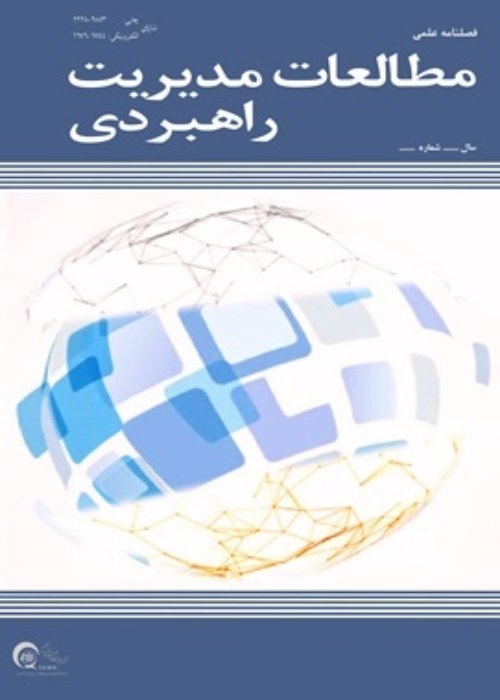Explanatory components of indigenous entrepreneurship from the perspective of different regions of Iran
Author(s):
Article Type:
Research/Original Article (دارای رتبه معتبر)
Abstract:
Introduction
Numerous studies have shown that innovation and entrepreneurship play a key role in different aspects including economic development, quality of life, and competitiveness on a global scale. Despite of similar parts that the regions have, their potentials, territorial assets, cultures and ways of thinking are diverse that guides them in choosing their unique development path. In this regard, studies of innovation systems reject the use of the same policies to design and guide the path of innovation-based development and consider it necessary to pay special attention to the different characteristics affecting innovation in each region.Previous studies of regional development have not dealt with the impact of social factors on regional innovation behavior due to its geographical breadth and historical depth, the existence of different ethnic groups with different cultures and at the same time centralized policy-making. Therefore, the study of entrepreneurship from a local perspective that shows the cultures, values, traditions, views and potentials of each region in Iran can provide a useful approach to formulate political and legal requirements to pave the correct way for effective use of the entrepreneurship concept based on culture and especial social structure based on every region. Entrepreneurship in the cultural sector needs more attention and support. Methodology
The most important reasons are due to the requirements of production and consumption of cultural goods, prevention of foreign culture spread in country, and the high potential of cultural industries to develop and create employment. Considering the cultural diversity in our country, it is very important to identify opportunities and potential talents in the field of local businesses in each specific region of the country and in such a context, the capacities and capabilities of the local subcultures of Iranian society and the role they can play in the process of local and national development should be discussed. Since Iran has different regions and climates with various cultural, social, geographical, etc. so it is necessary to identify the potentials and conditions of each region for economic and social policy-making. Regarding the urgent need to address the aforementioned challenges, this study conducted. The purpose of this study is to explain the variables of local entrepreneurship according to the potentials of different regions of Iran using a Meta-Synthesis Review. To conduct this research, all researches related to local entrepreneurship between 2006 and 2020 were reviewed. Finally, 91 articles were selected and reviewed. Results ana Discussion
We did the analyze of dates according to the steps presented by Barroso and Sandlowski in seven steps, 1. Defining the objectives of the research; 2. Systematic study of background; 3. Searching and selecting appropriate researches; 4. Information extraction; 5. Analysis and composition of findings from qualitative studies; 6. Quality control and 7. Findings, . In order to use newer sources, research related to the research topic was considered in the period 2006 to 2020. After reviewing the titles and abstracts of the researches, 263 related researches were selected. After reviewing the research abstract, 152 articles that had the most similarity and relevance to the research topic were selected.In this study, to validate the proposed model from the point of view of the focus group (experts), including two faculty members of Mazandaran University with entrepreneurial expertise and two PhD graduates in policy-making, was used in a systematic design and using the opinion. Experts in this field and making repeated corrections the validity of the research was reviewed and approved. In other words, to ensure the validity of the results with specific criteria of qualitative research, the necessary studies including acceptability and verification were performed. To increase the acceptance, the review method was used by experts and some experts in this field. For verification, in the final stage of the obtained classes, several experts were sent to review and confirm the submission and suggested points.Then, to evaluate the quality, with the help of selected experts, the 50-point scale of the Critical Assessment Skills Program was used and the researches were reviewed. The range of scores was considered as follows: Studies with a total score between 40 and 50 were considered excellent, 31 to 40 were very good, 21 to 30 were moderate, 11 to 20 were poor, and 0 to 10 were very poor. At this stage, 61 articles were deleted for scoring less than 30, and finally 91 articles were reviewed. In the present study, all the factors extracted through library studies were considered as a component (code). The information of each article (journal name, year of publication, authors' names, key variables, research result, proposed solutions and the province of the research) was entered in a table and a code (letter A and one number) was assigned to each research. Because some of the research was conducted in a specific city and village and the task of surveying spatial information was difficult, the province of that particular village or city was used to match the regions. Then, table (2) was prepared for presentation in this research. In the first column, the general classification of key indicators of local entrepreneurship extracted from research, in the second column, the concepts extracted from each research and in the third column, the codes related to related research are examined. Has been obtained and in front of each code, the province related to the research is listed. Conclusion
The results showed the 12 components of local entrepreneurship, including: artistic entrepreneurship, tourism entrepreneurship, rural entrepreneurship, women entrepreneurship, cultural entrepreneurship, regional entrepreneurship, sustainable entrepreneurship, traditional entrepreneurship, Wisely entrepreneurship, religious entrepreneurship, green entrepreneurship, medical entrepreneurship, and agricultural entrepreneurship were identified as explanatory components. Three components of rural entrepreneurship (26%); Tourism entrepreneurship (18%) and cultural entrepreneurship (12%) had the highest repetition rates among the research topics. According to the classification of regions, it was found that the highest number of articles on local entrepreneurship was related to the provinces of Tehran, Isfahan, Zanjan, Bushehr, and Mazandaran, which are among the most successful regions in the country's innovation systems. It is suggested that legal and systemic requirements and policies should be formulated to take advantage of these opportunities by both the local of the regions, and the whole country according to the local entrepreneurial potentials, and the gaps and shortcomings ahead of these potentials in each region. It is suggested that the status of each component of local entrepreneurship in the macro and sectoral policies of relevant institutions should be examined. One of the most important tools is the smart specialization strategy. Intelligent specialization is one of the newest regional development strategies which states that each region should set specific priorities according to the potential of the region, which is most appropriate in order to stimulate entrepreneurial culture and promote innovation in that region. It is suggested that future research using similar tools or instruments identify the local entrepreneurial priorities of each region.Keywords:
Language:
Persian
Published:
Journal of Strategic Management Studies, Volume:14 Issue: 53, 2023
Pages:
187 to 213
magiran.com/p2580072
دانلود و مطالعه متن این مقاله با یکی از روشهای زیر امکان پذیر است:
اشتراک شخصی
با عضویت و پرداخت آنلاین حق اشتراک یکساله به مبلغ 1,390,000ريال میتوانید 70 عنوان مطلب دانلود کنید!
اشتراک سازمانی
به کتابخانه دانشگاه یا محل کار خود پیشنهاد کنید تا اشتراک سازمانی این پایگاه را برای دسترسی نامحدود همه کاربران به متن مطالب تهیه نمایند!
توجه!
- حق عضویت دریافتی صرف حمایت از نشریات عضو و نگهداری، تکمیل و توسعه مگیران میشود.
- پرداخت حق اشتراک و دانلود مقالات اجازه بازنشر آن در سایر رسانههای چاپی و دیجیتال را به کاربر نمیدهد.
In order to view content subscription is required
Personal subscription
Subscribe magiran.com for 70 € euros via PayPal and download 70 articles during a year.
Organization subscription
Please contact us to subscribe your university or library for unlimited access!



